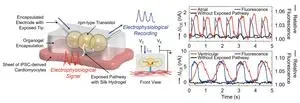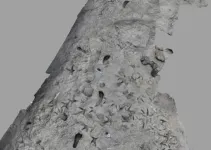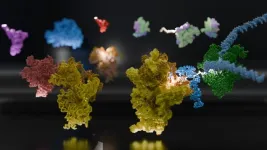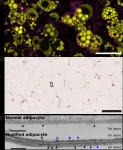Oxford University researchers have made a significant step towards realising a form of ‘biological electricity’ that could be used in a variety of bioengineering and biomedical applications, including communication with living human cells. The work has been published today (28 November) in the journal Science.
Iontronic devices are one of the most rapidly-growing and exciting areas in biochemical engineering. Instead of using electricity, these mimic the human brain by transmitting information via ions (charged particles), including sodium, potassium, and calcium ions. Ultimately, iontronic devices could enable biocompatible, energy-efficient, and highly precise signalling systems, including for drug-delivery.
Up to now, however, iontronic devices are typically set within solid scaffolds, which hinders their integration with soft tissues. In this new study, Oxford University researchers succeeded in developing miniature, multifunctional iontronic devices constructed from biocompatible hydrogel droplets. The hydrogels function as ionic analogues of electronic semiconductors, enabling ion movement to be controlled similar to the control of electron movement in electronics. The tiny microscale droplets are assembled with the aid of surfactants (soap-like molecules) and conduct ions after they have been triggered by light to link together (a technique developed by the group).
The researchers have named their collection of devices dropletronics, a compound of droplet and iontronics. By creating combinations of microscale nanolitre hydrogel droplets, the team produced dropletronic diodes, transistors, logic gates, and memory devices. The dropletronic devices perform better than any soft iontronic devices developed to date, including a higher efficiency and faster response time. They are even comparable to solid iontronic devices, with the added advantage of not being embedded in a hard matrix.
Dr Yujia Zhang (Department of Chemistry, Oxford University), the lead researcher for the study, said: ‘Ions have many advantages over electrons: for instance, the fact they have various sizes and charges means they could be used to achieve various functions in parallel. Through the incorporation of large ionic polymers, we demonstrated a dropletronic device with long-term memory storage, which has not been achieved with previous iontronic approaches and offers an unconventional pathway to neuromorphic applications.’
In addition to controlling ion movements, dropletronic devices can also interface with cells and record biological signals from them, since the devices and cells speak the same ‘ionic language’. In this study, the research team used the devices to produce biocompatible sensors to record electrical signals from beating human heart cells.
‘This is the first example of a lab-built biological sensor that can sense and respond to changes in function of human heart cells in a dish,’ said Dr Christopher Toepfer, Associate Professor of Cardiovascular Science at Oxford University’s Radcliffe Department of Medicine. ‘This finding is an exciting step towards the fabrication of more complex biological devices that will sense a variety of abnormalities in an organ and react by delivering drugs intelligently inside the body.’
The researchers envisage the integration of dropletronics with living matter, which would provide a biocompatible approach to direct ionic communication, including the possibility of identifying multiple vital ionic and molecular species, which will open up new possibilities in various areas, notably clinical medicine. Dropletronic circuits may also provide a route to build ionic logic systems that mimic neurons for neuromorphic information processing and computations.
Professor Hagan Bayley (Department of Chemistry, Oxford University), the research group leader for the study, said: ‘Dr Zhang has used a creative, highly multidisciplinary approach including aspects of electrochemistry, polymer chemistry, surface physics, and device engineering to produce the first microscale “dropletronic” devices. The functional capabilities of these structures demonstrate that they might soon be elaborated into practicable devices with applications in both fundamental science and medicine.’
Notes for editors:
For media enquiries, including interview requests, contact:
Professor Yujia Zhang, Oxford University / École Polytechnique Fédérale de Lausanne: yujia.zhang@epfl.ch
Professor Hagan Bayley, Oxford University: hagan.bayley@chem.ox.ac.uk
The study ‘Microscale droplet assembly enables biocompatible multifunctional modular iontronics’ will be published in Science on 28 November at 2 pm US Eastern Time (7 pm London time) and will be available at DOI: 10.1126/science.adr0428. Advance copies of the paper may be obtained from the Science press package, SciPak, at https://www.eurekalert.org/press/scipak/ or by contacting scipak@aaas.org
Images of this work can be downloaded here:
https://drive.google.com/drive/folders/1r5jvtnwLSfzlymaQjJDDsmRMTvsX2A7G?usp=drive_link
These images are for editorial purposes for the purpose of this press release ONLY and MUST be credited (see captions file in folder). They MUST NOT be sold on to third parties.
Related work:
A microscale soft ionic power source modulates neuronal network activity. Nature 620, 1001–1006 (2023). https://doi.org/10.1038/s41586-023-06295-y
A microscale soft lithium-ion battery for tissue stimulation. Nat Chem Eng (2024). https://doi.org/10.1038/s44286-024-00136-z
About the University of Oxford
Oxford University has been placed number 1 in the Times Higher Education World University Rankings for the ninth year running, and number 3 in the QS World Rankings 2025. At the heart of this success are the twin-pillars of our ground-breaking research and innovation and our distinctive educational offer.
Oxford is world-famous for research and teaching excellence and home to some of the most talented people from across the globe. Our work helps the lives of millions, solving real-world problems through a huge network of partnerships and collaborations. The breadth and interdisciplinary nature of our research alongside our personalised approach to teaching sparks imaginative and inventive insights and solutions.
Through its research commercialisation arm, Oxford University Innovation, Oxford is the highest university patent filer in the UK and is ranked first in the UK for university spinouts, having created more than 200 new companies since 1988. Over a third of these companies have been created in the past three years. The university is a catalyst for prosperity in Oxfordshire and the United Kingdom, contributing £15.7 billion to the UK economy in 2018/19, and supports more than 28,000 full time jobs.
About the Department of Chemistry, University of Oxford
The department’s mission is to advance the global understanding of chemistry, and to use that knowledge to address major challenges for society. Find out more at www.chem.ox.ac.uk
END





